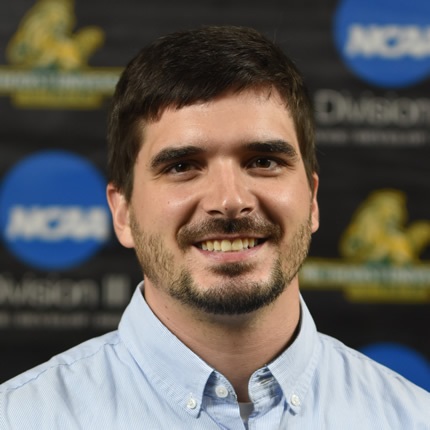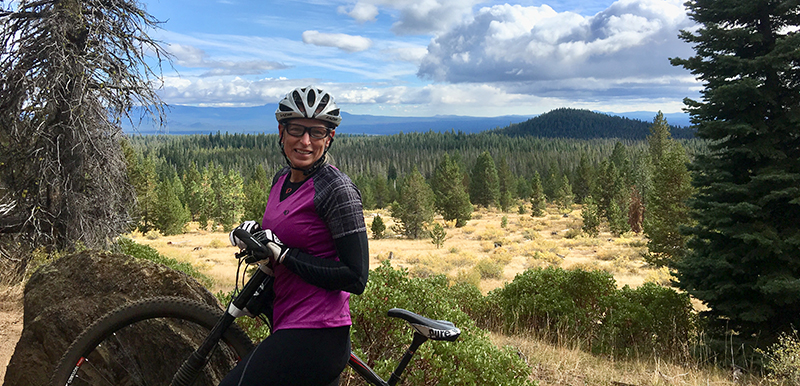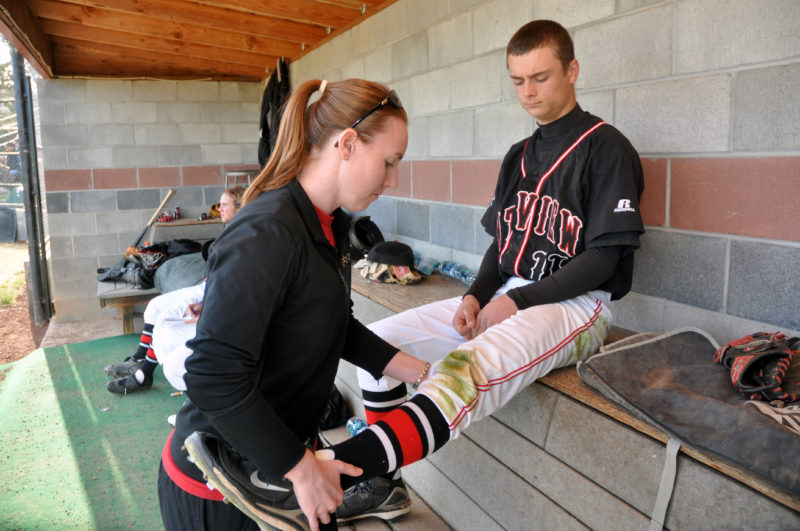 Shantyel Bowman, MAT, ATC
Shantyel Bowman, MAT, ATC
A native of Bend, Oregon, Shantyel Bowman attended college at Oregon State University. There, she received her Bachelor’s degree in Exercise and Sports Science in 2014. Following graduation, she headed to Montana to continue her studies and, in 2016, earned her Master’s in Athletic Training from Montana State University, Billings.
After completing her education, Shantyel moved back to reconnect with family and friends in Bend before starting her career. However, her first career move took her away from Central Oregon again. This time to Washington State where  she enjoyed just over two years as a practicing athletic trainer.
she enjoyed just over two years as a practicing athletic trainer.
With her heart still in Bend, Shantyel was excited when she saw an athletic training opportunity open up with The Center Foundation. And, we are thrilled to have her on our team! Now, you can find Shantyel at La Pine High School in the afternoons supporting the student athletes.
Shantyel loves her active Central Oregon lifestyle. For example, when she isn’t on the sports field or in the training room at her high school, you can find her hiking, mountain biking, and playing Frisbee. She also values spending time with family and friends, as well as creative pursuits like painting and the adventure of traveling.
 First Job?
First Job?
AT with ATI physical therapy
Favorite food?
Lettuce wraps
Something quirky/interesting about you?
I wear funky socks every day.
What is one thing you would like people to know about athletic trainers?
Athletic trainers are dynamic, quick-thinkers, with the ability to solve problems in a variety of circumstances, and use whatever is at hand to get the job done.
Shantyel Bowman, MAT, ATC is an athletic trainer with The Center Foundation and serves La Pine High School. Find out more about our athletic training team here.

 First, let’s talk about what asthma is. When we inhale, oxygen enters the lungs through structures called bronchi. Asthma is a spasm, or tightening, of the bronchi making it difficult to get air into the lungs. This lack of air can create unpleasant symptoms and limit activity. Asthma has many different triggers, but here we will specifically look at exercise-induced asthma.
First, let’s talk about what asthma is. When we inhale, oxygen enters the lungs through structures called bronchi. Asthma is a spasm, or tightening, of the bronchi making it difficult to get air into the lungs. This lack of air can create unpleasant symptoms and limit activity. Asthma has many different triggers, but here we will specifically look at exercise-induced asthma.
 suspect that you have asthma and experience the symptoms above, it may be time to make a visit to your doctor. With their help, you can put a plan in place to control your asthma and keep doing all the activities that you love this winter and beyond.
suspect that you have asthma and experience the symptoms above, it may be time to make a visit to your doctor. With their help, you can put a plan in place to control your asthma and keep doing all the activities that you love this winter and beyond.

 In order to accomplish this, we raise over $500,000 annually to provide sports medicine services to eight high schools in Bend, La Pine, Sisters, Madras, Culver and Crook County. However, we have more work to do. Specifically, our middle school athletes need support, and we have an additional high school coming online in 2021. As our region continues to grow, so does our opportunity to keep kids active and safe. This is where YOU come in. Our kids depend on us; we depend on you to keep us here protecting them. If every parent of a high school athlete in Central Oregon gave just $10 a month for one year (that’s only two visits to Starbucks!) it would go a log way toward reaching our goals.
In order to accomplish this, we raise over $500,000 annually to provide sports medicine services to eight high schools in Bend, La Pine, Sisters, Madras, Culver and Crook County. However, we have more work to do. Specifically, our middle school athletes need support, and we have an additional high school coming online in 2021. As our region continues to grow, so does our opportunity to keep kids active and safe. This is where YOU come in. Our kids depend on us; we depend on you to keep us here protecting them. If every parent of a high school athlete in Central Oregon gave just $10 a month for one year (that’s only two visits to Starbucks!) it would go a log way toward reaching our goals. Tis the season of coughing, sneezing, and runny noses – not just roasted chestnuts over an open fire and sleigh rides in the snow. The scourge of cold and flu season is here. The U.S. Centers for Disease Control and prevention (CDC) estimates that there are over 425 million cases of the cold and flu every year. In an active community such as ours, the question often comes up as to whether you should exercise or rest while sick. Can you “burn it out” with a good run, or do you just need some serious downtime? The answer is…it depends.
Tis the season of coughing, sneezing, and runny noses – not just roasted chestnuts over an open fire and sleigh rides in the snow. The scourge of cold and flu season is here. The U.S. Centers for Disease Control and prevention (CDC) estimates that there are over 425 million cases of the cold and flu every year. In an active community such as ours, the question often comes up as to whether you should exercise or rest while sick. Can you “burn it out” with a good run, or do you just need some serious downtime? The answer is…it depends. We are excited to announce our
We are excited to announce our  Understanding Concussions
Understanding Concussions helmet itself cannot prevent a concussion, research shows that improper fit of the helmet can increase concussion symptom severity and duration. Next, proper tackling technique can help to reduce the risk of concussion by using the shoulder to initiate contact instead of using the head. Finally, neck strengthening can also be beneficial to help stabilize the head and dissipate the forces transferred to the head during collisions and rapid head rotations.
helmet itself cannot prevent a concussion, research shows that improper fit of the helmet can increase concussion symptom severity and duration. Next, proper tackling technique can help to reduce the risk of concussion by using the shoulder to initiate contact instead of using the head. Finally, neck strengthening can also be beneficial to help stabilize the head and dissipate the forces transferred to the head during collisions and rapid head rotations. A native of Lewiston, Maine, Nicole attended Dakota Wesleyan University for her undergraduate degree, earning a Bachelor of Science in Athletic Training. After graduating, Nicole went on to South Dakota State University where she earned her Master of Science in Exercise Science. While at South Dakota State Nicole enjoyed her time as a Graduate Assistant Athletic Trainer for the Men’s and Women’s Track and Field and Cross Country Teams.
A native of Lewiston, Maine, Nicole attended Dakota Wesleyan University for her undergraduate degree, earning a Bachelor of Science in Athletic Training. After graduating, Nicole went on to South Dakota State University where she earned her Master of Science in Exercise Science. While at South Dakota State Nicole enjoyed her time as a Graduate Assistant Athletic Trainer for the Men’s and Women’s Track and Field and Cross Country Teams.





